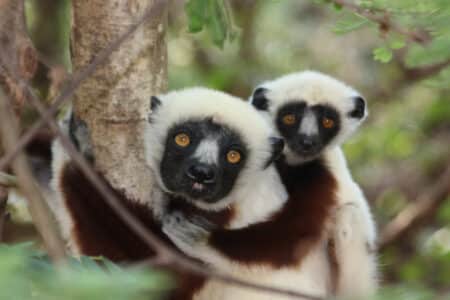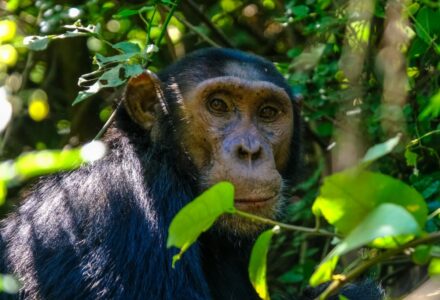Primates are an order of mammals that include lemurs, monkeys, apes, and humans.
Primates are characterized by their complex social systems, large brains, visual acuity, and, in some species, opposable thumbs. The common ancestor of all primates is believed to have existed approximately 63 million years ago, towards the end of the Cretaceous Period. This coincides with the extinction of the dinosaurs and the dawn of the “golden age” of mammals.
Today, there are well over 300 species of living primates, with the exact number varying due to the use of different classification systems. New species are still being discovered; the most recent being Schneider’s marmoset (Mico schneideri), which was first described in 2021 in northern Brazil.
Primates Overview

60 Species of Primates
- Allen’s swamp monkey
- Atlantic Forest titi monkey
- Aye-aye
- Azara’s night monkey
- Bald uakari
- Black bearded saki
- Black-crested mangabey
- Black howler monkey
- Blue Nile patas monkey
- Bonobo
- Bornean orangutan
- Brown greater galago
- Central African potto
- Chacma baboon
- Chimpanzee
- Diana monkey
- Drill
- Eastern hoolock gibbon
- Eastern pygmy marmoset
- Emperor tamarin
- Gabon talapoin
- Gelada
- Goeldi’s marmoset
- Golden angwantibo
- Golden snub-nosed monkey
- Golden-headed lion tamarin
- Gray slender loris
- Gray-shanked douc
- Hairy-eared dwarf lemur
- Human
- Humboldt’s squirrel monkey
- Illiger’s saddle-back tamarin
- Indri
- King colobus
- Kipunji
- Mandrill
- Mantled guereza
- Northern muriqui
- Olive baboon
- Olive colobus
- Pale fork-marked lemur
- Peruvian spider monkey
- Philippine tarsier
- Pig-tailed langur
- Proboscis monkey
- Purple-faced langur
- Red-tailed sportive lemur
- Rhesus macaque
- Ring-tailed lemur
- Schneider’s marmoset
- Senegal bushbaby
- Siamang
- Sooty mangabey
- Tufted capuchin
- Verreaux’s sifaka
- Vervet monkey
- Western gorilla
- White-headed marmoset
- Yellow-cheeked gibbon
- Zanzibar red colobus
How Many Species Are There?

There are between 376 and 524 living species of primates, grouped into 81 genera, depending on how they are classified. Over 200 species are endangered or critically endangered, according to the IUCN.
Interestingly, the term “monkey” refers to many different groups of primates, including baboons, gorillas, macaques, marmosets, and gibbons, among others. “Monkeys” are divided into two families, “Old World” and “New World” monkeys.
Where Do They Live?

- Tropical rainforests: Primates are primarily found in this biome, making their homes in the trees.
- Temperate forests
- Savannas
- Shrublands
- Wetlands
- Swamps
- Semi-deserts
- Every other biome: Of course, humans populate every biome worldwide.
Types of Primates
Gorillas
These incredible, yet endangered, animals are found around central Africa. Led by dominant males called silverbacks, these gorilla troops share many human characteristics. Click on any of the articles below or go to our dedicated gorillas page to learn more.
-

Baby Gorilla Transferred to Foster Parents at Cleveland Zoo
-

Dwayne “The Rock” Johnson Vs. Silverback Gorilla
-

Gabon’s Wild Gorillas Could Hold the Secret to Fighting Drug-Resistant Bacteria
-

Giant Gorilla Spotted on Baby Monitor Causes Panic but Turns Out to Be Optical Illusion
-

Giant Gorilla Surprises Photographer
-

Gorilla Mom Shows Off Her Baby to Boston Zoo Visitors
Learn More About Primates
-

20 Things You May Not Have Known About Lemurs
-

21 Most Endangered Primates – That You’ve Never Even Heard Of
-

30 Breastfeeding Mothers to Teach Orangutan Who Lacks Maternal Qualities To Make Sure Her Baby Survives
-

7 Critically Endangered Spider Monkeys Found At Texas Border
-

A Rare Encounter With Baboons In My Garden
-

Baboon Re-Creates Iconic Movie ‘The Lion King’ by Carrying Lion Cub
Well-Known Primates
| Habitat range | Diet | Conservation status | |
| Chimpanzee | Tropical African forests & savannahs | Omnivorous frugivores | Endangered |
| Baboon | Open African savannahs & woodlands | Omnivores | Least concern; Near threatened |
| Gorilla | Equatorial African tropical forests | Herbivores | Critically endangered |
| Orangutan | Southeast Asian rainforests | Omnivorous frugivores | Critically endangered |
| Macaque | Tropical rainforests & temperate mountains in Asia, North Africa, Gibraltar | Frugivores | Endangered |
| Lemur | Madagascan forests | Omnivores | Threatened |
| Marmoset | South & Central American forests | Insectivores & Frugivores | Least concern; some spp. endangered |
| Gibbon | South Asian tropical & subtropical rainforests | Omnivorous frugivores | Endangered; Critically endangered |
Primate Images






Monkeys vs. Apes
| Monkeys | Apes | |
| Geographical range | Africa, Asia, Americas | Africa, Asia |
| Body size | Smaller | Larger |
| Tails | Most have tails | Absent |
| Cognition | Less advanced | More advanced |
| Number of species | 330+ | 34+ |
| Examples | Baboons, macaques, spider monkeys, marmosets, uakaris | Orangutans, gorillas, chimpanzees, gibbons, humans |
Primate Records
Old World vs. New World Monkeys
| Old World Monkeys | New World Monkeys | |
| Geographical range | Africa, Asia, Europe | Americas |
| Body size | Medium to large | Small to medium |
| Appearance | Narrow nose, downward-pointing nostrils | Wide nose, sideways-pointing nostrils |
| Thumbs | Opposable | Most non-opposable |
| Number of species | 200+ | 130+ |
| Examples | Baboons, macaques, colobus, langurs | Spider monkeys, marmosets, uakaris, sakis, tamarins |
7 Fun & Surprising Facts
- Opposable thumbs are a unique trait of primates.
- Most primates are highly social and live in troops, clans, or bands.
- Several primate species use tools for foraging or cracking nuts.
- Some primates are nocturnal.
- Some primate species practice monogamy and mate for life.
- Primates often display exceptional parental care.
- Most primates have excellent color vision, which helps them pick out ripe fruits to eat.
Primate News
-

One of the Most Endangered Species is The Gorilla
-

The Street Dancing Lemurs of Madagascar
-

Gorilla Vs. Hippo
-

10 (Party) Animals That Enjoy Drugs
-

Dwayne “The Rock” Johnson Vs. Silverback Gorilla
-

The 9 Smallest Mammals In the World
-

The Greatest Showdown Between a Tiger and a Gorilla
-

The Largest Chimpanzee Ever Recorded
-

Gorilla Vs. African Forest Buffalo
Primate FAQs
Most primates are omnivores and will eat fruits, nuts, seeds, bark, roots, and tubers in addition to eggs, insects, lizards, small mammals, and frogs. Many primates, such as chimps and macaques, will supplement most of their diet with fruit. Others, including gorillas, are herbivores and prefer consuming foliage such as succulents, leaves, stems, and shoots.
Primates communicate in a variety of ways, including audibly, visually, and, sometimes, olfactorily (by smells) and tactilely (by touch). Examples of visual signals include chest beating and teeth baring. Audible signals include various distinct vocalizations. Other communication signals include scent marking and slapping.
Primates engage in various levels of social organization, depending on the species. These structures include neighborhood systems, where different groups occupy similar territories with little conflict, family systems, where a mated pair will live alone with their offspring, large territorial groups, or hierarchical systems with different levels of rank.
Primates often disperse seeds throughout the environment, typically via dung, they control population numbers of smaller animals they prey on, they trample the forest floor, allowing for the decomposition of forest waste, and they are prey for larger animals.
Primates can be predators, just as they can be prey. Even the world’s largest extant primate, the eastern gorilla, which is a herbivore by the way, is preyed upon. The only predators of larger primates are big cats like leopards, lions, and jaguars. Smaller primates are preyed upon by big to medium-sized cats, raptors, and snakes. Of course, we cannot forget that humans hunt primates too, and pose the greatest threat to their populations.
Latest News on Primate Conservation

Approximately 65.5% of primate species are threatened with extinction, including 16.9% being critically endangered. Thus, many primates are among the most threatened species worldwide.
There are several reasons for this. Firstly, most primates live in forest habitats, which are increasingly being destroyed and defragmented by humans both for resources and for land. Second, many primates are illegally captured to be traded as exotic pets, poached for use in traditional medicine, or hunted for their body parts or meat. Next, many primate species are susceptible to the same diseases that humans are, and so outbreaks of diseases such as Ebola threaten their populations. Finally, climate change causes environmental stressors that disrupt their normal behavior like mating and foraging.
In recent years, with the rising concern for the endangerment of primates, more organizations have dedicated their efforts to primate conservation. The Dian Fossey Gorilla Fund International, World Wildlife Fund, and The Orangutan Project are examples of organizations dedicated to primate conservation.
Some conservation approaches include habitat restoration, captive breeding and reintroduction programs, education and outreach initiatives, ecotourism development, and sustainable development practices.
Mischief & Mayhem

Many primates are rambunctious and mischievous, somewhat reminiscent of us humans when we were little kids. In places where monkeys like rhesus macaques and vervet monkeys are common, the locals are all too familiar with the naughty antics of these guys. These cheeky creatures can often be caught digging through rubbish bins, hopping into your kitchen window in pursuit of an easy meal, or stealing your backpack that you set down. Luckily, however, they aren’t too dangerous. The only time you’re at any risk of an attack is if you go near their young, as mothers are often incredibly protective.
It is advisable that you leave primates alone, even when they are your neighbor. Just remember to seal your rubbish, close your windows, and don’t leave anything that might hold food unattended.
Learn more about mammals:
Newest Category: Primates
- Discover: Animals Can Catch Yawns - June 25, 2025
- The Fascinating World of Hybrid Animals - June 24, 2025
- Wild Animals React to Seeing Themselves in Mirror - June 22, 2025

